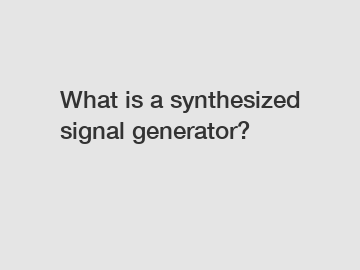What is a synthesized signal generator?
Understanding a synthesized signal generator
A synthesized signal generator is a device used in electronics to generate various types of signals for testing, calibration, and measurement purposes. It is a versatile tool that can produce different waveforms such as sine waves, square waves, sawtooth waves, and more. Unlike traditional signal generators that use fixed frequency oscillators, a synthesized signal generator uses digital synthesis techniques to generate signals with precise frequencies and low phase noise.
How does a synthesized signal generator work?
Step 1: Set the desired signal parameters – Start by inputting the desired frequency, amplitude, waveform, and modulation settings into the synthesized signal generator.
Step 2: Frequency synthesis – The synthesized signal generator uses a stable reference oscillator to generate a base frequency, which is then multiplied or divided to achieve the desired output frequency.

Step 3: Waveform generation – Using digital signal processing techniques, the synthesized signal generator creates the desired waveform by converting the digital signal into an analog output with the specified characteristics.
Step 4: Modulation – If modulation is required, the synthesized signal generator can apply amplitude modulation (AM), frequency modulation (FM), phase modulation (PM), or other modulation techniques to the output signal.
Key features of a synthesized signal generator
Step 5: Frequency accuracy – A synthesized signal generator offers high frequency accuracy and stability, ensuring precise signal generation for testing and calibration purposes.
Step 6: Low phase noise – By utilizing digital synthesis techniques, synthesized signal generators can achieve low phase noise levels, making them ideal for applications that require low noise signals.
Step 7: Wide frequency range – Synthesized signal generators can cover a wide frequency range, from a few hertz to several gigahertz, allowing them to generate signals for a diverse range of applications.
Step 8: Modulation capabilities – With built-in modulation features, synthesized signal generators can easily produce modulated signals for testing communication systems, radar systems, and other applications that require modulation.
Overall, a synthesized signal generator is a versatile and essential tool for engineers, technicians, and researchers working in a variety of industries, including telecommunications, aerospace, defense, and electronics. Its ability to generate accurate, stable, and low noise signals makes it an invaluable asset for signal generation and testing applications.
Are you interested in learning more about Microwave Signal Generator supplier, Spectrum Analyzer Low Frequency, high-quality arbitrary waveform generator? Contact us today to secure an expert consultation!

Comments